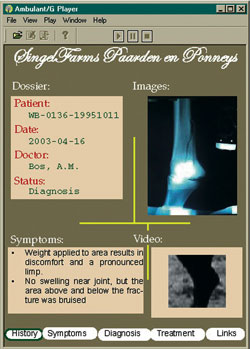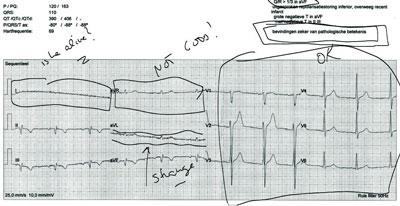Ambulant Player: A Universal Multimedia Player
by Annette Kik and Dick Bulterman
Putting your CD collection on computer, sending pictures with your cell phone: Multimedia technology appears more and more in daily life. Shortly it also will be possible to take fragments of TV programs and share them with your chat partners. Researchers at CWI are developing a software infrastructure to create multimedia presentations for parallel and distributed systems. This has applications in health care and at home. As a first step they developed the Ambulant Player, an open source multimedia player, as a test platform for researchers all over the world.
Multimedia researchers use many different kinds of multimedia players. This makes comparing results difficult. With the Ambulant Player CWI has created an environment everybody can use. At the moment it is one of the fastest and most complete SMIL-standard-based media players in the world. In addition the Ambulant Player is quite portable: It can be used on PCs and Macs as well as on PDAs. The player was released in August 2004 as open-source software and was funded by NLnet. It can be downloaded from the CWI website.
The Ambulant Player is the first step towards a software infrastructure to create multimedia presentations for parallel and distributed systems. SMIL, the W3C's Synchronized Multimedia Integration Language, enables users to integrate sound, images, film and text into one multimedia presentation that can be played on a wide variety of devices and shared via the Web. Currently, image and sound are played from one server. In the future this should be done from more servers simultaneously. This requires exact tuning of the different data streams.
|
One of the possible applications of this research is to compile, maintain and enrich medical files. A pilot project was conducted with electronic medical files of horses containing text, sound, images, and video. Multimedia is especially useful in this case. Since horses do not talk, vets must rely on observations of the animal's behaviour and on medical data. When a vet wants to consult a colleague, it is easier to transport a detailed file than the horse itself. Furthermore, vets are more inclined to cooperate since most horses are not insured. Physicians are under pressure from government and insurance companies, leaving less time for experiments.
Building up an electronic medical file takes several steps. First it requires an administrative entry. Just as with humans a basic number of administrative data are needed that can be consulted both locally and from far away. Next media data must be collected. During diagnosis text, image, sound and video images can be stored. Subsequently all irrelevant material is removed. Finally, a report is generated using a multimedia editor based on templates.
|
For physicians it is also important to annotate data. They can for example make notes for remarkable parts in an electro cardiogram, or they can circle a fracture on an X-ray. This way other physicians can quickly see what is wrong. They can also record comments with video recordings and consequently want to accelerate or slow down the images while the comments stay the same. This creates enormous challenges. For this purpose CWI develops the Ambulant Annotator.
The Ambulant project builds on CWI's long history in the area of multimedia. CWI researchers developed the CMIF language for synchronizing over networks. Around 1993 this language was the basis for SMIL, now the world-wide standard thanks to the World Wide Web Consortium. The institute is one of the main suppliers for W3C's SMIL working group.
Links:
http://www.ambulantplayer.org
http://www.cwi.nl/sen5
Please contact:
Dick Bulterman, CWI, The Netherlands
Tel: +31 20 592 4300
E-mail: Dick.Bulterman![]() cwi.nl
cwi.nl

 This issue in
This issue in 

